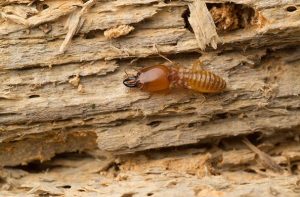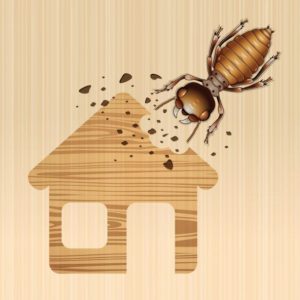Insect pests are a serious threat to the longevity of timber houses. Insect larvae destroy the structure of even the hardest wood species, turning the material into dust in a very short time. Even if outwardly the timber seems to be healthy, it will quickly lose its strength, which threatens the complete destruction of the house. It is important to timely recognize the presence of pests and find the most effective way to destroy them.
The Main Types of Pests
Wood is threatened by several types of pests: the most dangerous among them are termites, bark beetles, and woodworm, which is also called the woodworm beetle. Just one colony of termites can completely destroy the roof system of a house in one year, as a result of which the roof is threatened with collapse.
several types of pests: the most dangerous among them are termites, bark beetles, and woodworm, which is also called the woodworm beetle. Just one colony of termites can completely destroy the roof system of a house in one year, as a result of which the roof is threatened with collapse.
Tree beetles can destroy all walls and partitions in three years. The bark beetle mainly destroys the upper layers of the tree. It lives in the places where the bark adheres to the fibers. This leads to the appearance of characteristic marks on the surface of the lumber. They become much weaker.
It is possible to identify the presence of pests by several characteristic signs:
- The mediums of the tunnels are on the remains of the cortex; they are usually visible to the naked eye. Sinuous stripes indicate the defeat of the tree by the bark beetle.
- Reduced weight of the board or timber, the appearance of holes on the surface. This is a clear sign of damage by the woodworm beetle.
- The appearance of wood flour – dark brown dust. It is the result of wood processing by almost all insects. Therefore, it is a universal sign.
The hardest thing to spot is a termite colony. They make hidden passages in the tree, invisible from the surface. In this case, the wood is destroyed very quickly.
Wood Pest Control Methods
To combat all types of insects, two types of measures are used – preventive and operational. Prevention consists of processing wood directly at the harvesting sites. If the woodworm beetle, termites, or bark beetle have already started in the built house, it is necessary to apply operational control measures. They include:
of insects, two types of measures are used – preventive and operational. Prevention consists of processing wood directly at the harvesting sites. If the woodworm beetle, termites, or bark beetle have already started in the built house, it is necessary to apply operational control measures. They include:
- Injection of pesticides into the passages made by insects. Initially, the inlets are purged. To free them from wood flour, then a solution of sodium fluoride is poured into them with a syringe. To enhance the effect, the passages are closed with corks made of poisoned bread to destroy all the larvae.
- Introducing a solution of copper sulfate, turpentine, kerosene, or other substances dangerous to insects into the holes.
- Freeze at temperatures below -2 degrees for at least two days. The method is effective, but the residential building will have to be completely vacated for some time to wait for the destruction of the pests.
Comments are closed